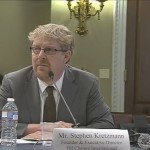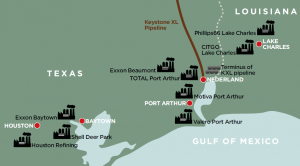The Keystone XL pipeline is a project that must be rejected. See below for resources and ways to get involved!
What can you do?
- Send a comment to the State Department by March 7th, expressing your concerns with the project.
- Join the 70,000 who have already taken the Pledge to Resist the Keystone XL pipeline, including by risking arrest if necessary, should the project move forward.
Key Reports, Briefings and Fact Sheets on Tar Sands and the Keystone XL pipeline
Read testimony given in the House of Representatives on April 16, 2013 by Oil Change International Executive Director Steve Kretzmann on the Keystone XL pipeline. A good overview of the key issues around the pipeline and the key deceptions by its proponents.
Cooking the Books: How the State Department Analysis Ignores the True Climate Impact of Keystone XL – a new report authored by Oil Change International and endorsed by the Sierra Club, the Natural Resources Defense Council, Environment America, 350.org, the National Wildlife Federation, Greenpeace and Friends of the Earth shows that the Keystone XL tar sands pipeline would, if approved, be responsible for at least 181 million metric tons of carbon dioxide equivalent (CO2e) each year, comparable to the tailpipe emissions from more than 37.7 million cars or 51 coal-fired power plants. April 16, 2013
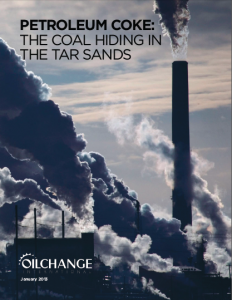 Petroleum Coke: The Coal Hiding in the Tar Sands. Oil Change International, January 2013.
Petroleum Coke: The Coal Hiding in the Tar Sands. Oil Change International, January 2013.The Canadian tar sands have been called the “most environmentally destructive project on earth”, with good reason. It is a well established fact that full exploitation of the tar sands is a grave threat to the climate. Emissions from tar sands extraction and upgrading are between 3.2 and 4.5 times higher than the equivalent emissions from conventional oil produced in North America. But as bad as these impacts already are, existing analyses of the impacts of tar sands fail to account for a byproduct of the process that is a major source of climate change causing carbon emissions: petroleum coke – known as petcoke. Petcoke is the coal hiding in North America’s tar sands oil boom.
Research has shown that the pipeline’s major purpose is not to provide oil for the U.S., but to serve as an export pipeline fueling international markets. New data reveals that a full 60 percent of gasoline produced in 2012 at Texas Gulf Coast refineries was exported. These are the refineries that would process the majority of the tar sands bitumen flowing through the Keystone XL pipeline, if it were built.
Tar sands crude oil is exempt from paying into America’s Oil Spill Liability Trust Fund. This is worth over $375 million to the tar sands industry between 2010 and 2017. The exemption exists despite tar sands pipelines spilling more often than pipelines carrying conventional oil and these spills being more difficult and expensive to clean up. The tar sands exemption is irrational and poses a risk to public health.
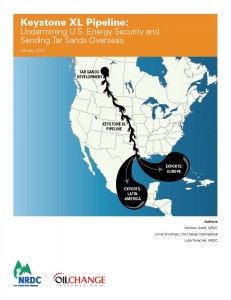 Keystone XL: Undermining Energy Security and Sending Tar Sands Overseas. Oil Change International and Natural Resources Defense Council, January 2012.
Keystone XL: Undermining Energy Security and Sending Tar Sands Overseas. Oil Change International and Natural Resources Defense Council, January 2012.The Keystone XL pipeline has been presented as a boon to U.S. energy security by its proponents. It is no such thing. This report details how Keystone XL would not enhance U.S. energy security as it would simply feed a growing export market on the Gulf Coast. It explains that genuine energy security can be achieved by maximizing efficiency not maximizing Big Oil’s profits.
Keystone XL is a proposed 1,700 mile crude oil pipeline that is designed to bring tar sands derived crude oil from Albe
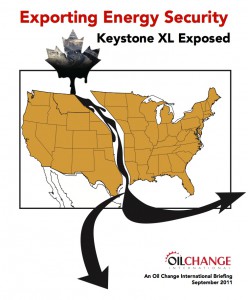 rta, Canada to Texas. Its proponents claim that Keystone XL and the Canadian crude oil it will deliver will enhance U.S. energy security. This fact sheet explains why this claim is false.
rta, Canada to Texas. Its proponents claim that Keystone XL and the Canadian crude oil it will deliver will enhance U.S. energy security. This fact sheet explains why this claim is false.
The new realities of the global oil market and the companies who will profit from the pipeline reveals that the Keystone XL pipeline will not lessen U.S. dependence on foreign oil, but rather transport Canadian oil to American refineries for export to overseas markets.
Recent press releases on the Keystone XL pipeline
- Release of “Cooking the Books: How the State Department Analysis Ignores the true Climate Cost of the Keystone XL Pipeline.” April 16, 2013. https://priceofoil.org/2013/04/16/cooking-the-books-the-true-climate-impact-of-keystone-xl/
- Statement on the Senate passage of the Hoeven non-binding amendment in support of Keystone XL. March 22, 2013. Senators Supporting KXL Took Nearly $31 Million From Fossil Fuel Industry Before Vote.
- Response to draft environmental impact statement issued by the US State Department regarding the Keystone XL pipeline. March 1, 2013. Oil Change International: Obama Administration Draft Keystone XL EIS Understates Climate Impact, Ignores Pipeline’s Purpose of Exporting Oil Abroad
- Release of new Oil Change International research on petroleum coke and the Keystone XL pipeline. New Research Shows Climate Emissions from Keystone XL Tar Sands Pipeline Much Worse Than Reported, January 17, 2013.
The Dirty Energy Money behind Members of Congress pushing Keystone XL
Pro-Keystone XL Senate bill follows pattern of following the oil money, March 14, 2013:
Compared to the rest of the Senate, the co-sponsors of today’s pro-KeystoneXL bill have received 227% more in fossil fuel-related campaign contributions on average than their counterparts.
Latest pro-Keystone XL effort comes from oil-fueled Congressmen, March 7, 2013:
The co-sponsors have, on average, received over $662,000 in fossil fuel-related campaign contributions in their careers. That’s over 410% more than the average member of the House of Representatives.
Senators send pro-Keystone XL letter, once again drenched with oil money, February 26, 2013:
The Senators who signed the pro-Keystone XL letter have received roughly 236% more in donations on average from fossil fuel interests than those that did not sign the letter.
Latest pro-Keystone XL letter from Congress once again awash with oil money, January 29, 2013:
Those Representatives that signed the letter received roughly 250% more money from oil and gas interests compared to those Representatives who did not sign the letter.
Pro-Keystone XL Letter Dripping in Fossil Fuel Money, January 23, 2013:
Senators who signed this letter have received – on average –340% MORE in campaign contributions from fossil fuel industry interests than those who had the sense to stay away.
See below for more information…
What is Keystone XL?
Keystone XL is a pipeline proposed by TransCanada that would connect the tar sands in Alberta, Canada to giant refineries in Texas, in order to export the oil around the world. The proposed pipeline would be 1,700 miles long and cross six U.S. states, threatening to contaminate freshwater supplies in America’s agricultural heartland and to massively increase greenhouse gas emissions in its wake.
Tar sands oil is extreme oil in every way. Its extraction is particularly energy and water-intensive, polluting, and destructive. It is either strip mined or produced by injecting high-pressure steam into the ground to melt the bitumen and get it to flow to the surface. To process it into usable fuel requires complex upgrading and refining that is also highly energy intensive and polluting.
Tar sands oil is more dangerous to transport because it is more corrosive to pipelines. When something goes wrong, as it inevitably does, it is very difficult to clean up a tar sands spill. Tar sands oil is more polluting to produce, transport and refine than conventional oil because it contains more carbon and more toxic substances, such as heavy metals and sulfur.
History of the pipeline project:
The Keystone XL pipeline was first proposed by TransCanada and its partners in 2008. In the years that have followed, a number of standard review processes have been undertaken by state and federal agencies. The ultimate approval power for the project rests in the President and the State Department, owing to the fact that the pipeline crosses the Canada-U.S. border and thus requires a National Interest Determination and Presidential Permit to move forward.
The process for reviewing this pipeline proposal has been wrought with controversy, political wrangling, Big Oil influence, and inadequate impact assessments. The original application was subject to additional supplementary review after citizens around the country — and along the originally proposed route Nebraska in particular — raised concerns about the pipeline’s potential impacts on the Ogallala Aquifer and fragile sand hills ecosystems. First Nations and Native Americans have consistently raised strong objections to the tar sands in general and the Keystone XL pipeline in particular as well.
In December of 2011, Congress passed a bill requiring the President to make a decision within 60 days. This arbitrary deadline essentially forced the President to reject the original pipeline proposal in January of 2012, who in doing so cited concerns about the route’s impacts on water and ecosystems and the inability to fully review these potential impacts in the timeframe Congress imposed.
In May of 2012, TransCanada put forward a new proposal for the Keystone XL pipeline. The State Department subsequently began a new review process, with the latest draft environmental impact statement having been released in March of 2013. The impact statement will undergo a 45-day public comment period, followed by a 90-day National Interest Determination period, wherein the President and the State Department will review the impact statements, comments from additional government agencies, and other relevant materials and arguments to make a decision as to whether the project is in line with the “national interest.” A final decision on the project is expected in October 2013, assuming no further delays or complications in the review process.

